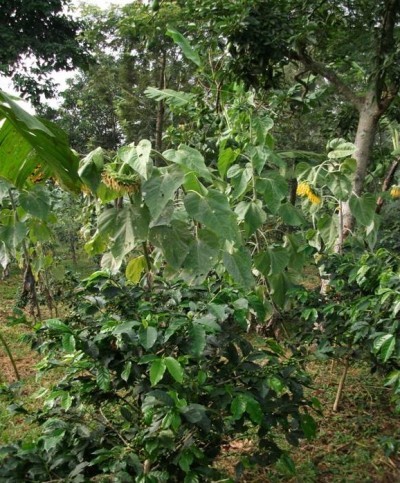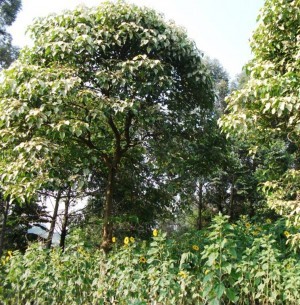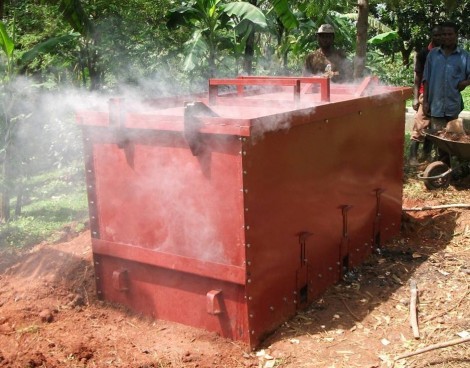Africa as a continent has the largest growing population in the world and an African sustainable farming and land management system will be critical to supporting the expanding population in the years to come. Kahangi Estate has developed a unique system that is not dependant on external inputs and is applicable to large and small farming units.
Minimum Tillage and intensive intercropping preventing erosion and evapotranspiration, are combined with on farm processingusing solar power and biodiesel. Shade trees provide fuel for processing the organic crops, nuts for biodiesel, and sustainable charcoal. The waste from processing is managed and recycled, including the difficult to handle wet coffee processing waste.
Soil Structure – Preventing Erosion and Evaporation
The Estate has adopted a system of minimum tillage and intensive intercropping. This system allows for the production of annual crops combined with perennial crops while not leaving the soil vulnerable to erosion and degradation. The development of a proper soil structure is crucial for good water management in the soil and reduces the crops vulnerability to climate change and climate fluctuations. The intense bio diversity of the plants develops a diverse range of soil microbes which in turn provides natural fertility to the crops. Typical examples of intensive intercropping on the farm is the production of coffee, fuel wood, avocados, bananas, sunflower and beans all in one area.
Ground cover is maintained with no clean cultivation which is crucial for the maintenance of the soil’s micro-organisms which in turn feed the plants. The ground cover prevents soil erosion while at the same time preventing evaporation of water from the top soil. (Kahangi Estate Data)
Intercropping, Recycling Waste and Sustainable Processing
All organic crops are intercropped and/or stacked so that one crop provides shade and nutrient recycling for the lower crop. For example the seeds from shade trees in the coffee are harvested for the processing of biodiesel fuel. The waste from the extraction process is then re used on the coffee fields.
The Estate where possible conducts its own on farm processing, this not only provides employment for the rural community around the farm but also allows the farm to recycle processing waste on the farm and run a closed system of farming. For example the shade trees in the coffee are pruned at the beginning of the rainy season, which in turn provides fuel wood for the processing department. The ash for the processing department is then returned to fields to provide nutrients for the crops.
Waste which is not suitable for direct application on crops such as coffee pulpery waste and oil filtering residues are broken down in a waste recycling unit. This unit uses a combination of anaerobic and aerobic systems to break down the waste into a state where it can be recycled on the crops.
Green Energy – Solar Power
There is no mains electrical supply to the area and the Estate has gone to great lengths to develop sustainable power sources to process its products. The cornerstone of the power supply are two banks of solar panels generating a maximum of 4.5kw of power. The power is converted into 3ph to run some of the processing equipment via a system of inverters and a 5kw converter. This not only provides lighting needs but also produces sufficient power to conduct processing procedures, such as coffee hulling, oil filtering, and packaging operations completely from solar power. 70% of the energy used to process and pack the products of Kahangi Estate comes from solar power.
Solar collectors are used to heat water at the farm and this assists in maintaining high hygiene standards in the processing of the oils as well as reducing energy consumption by pre heating water for other operations.

BioDiesel
The shade trees in the farm also provide seed and nuts which are processed into BioDiesel and used in the farm pickup as well as the 12kw generator. This provides power for processing during the early morning and late afternoon periods. In 2006 the Estate developed its own biodiesel processed from the Candle Nut Tree (Aleurites Moluccana). The tree is cultivated on the Estate both as an ornamental tree and also as a windbreak. The nuts are harvested from the trees, dried crushed and processed into the biodiesel fuel.
Coffee Wastewater Management System
The problem of how to manage wastewater from wet coffee processing has haunted the coffee industry for many years. Alan Tulip, Director of Kahangi Estate, has been extensively researching and pioneering new natural methods of handling coffee waste.
These rely on using natural means to break down the wastewater, allowing it to be usefully recycled or discharged without massive negative impacts on the environment.
At Kahangi Estate all the waste water and coffee cherry skins are fed through a digester which allows all the nutrients to be applied back to the crops by means of overhead sprinklers
Wet processing, when the harvested coffee cherries are pulped within 24 hours of picking, provides a better quality of coffee. However, this uses a lot of water and there are two principle problematic waste products. The first, the waste water contains a lot of mucilage and goes acidic with a very bad smell. The second, the cherry skins, decompose very slowly and also has a very bad smell. The light parchment husk, left after the wet processed coffee has dried, can be more easily be recycled or used as fuel.
After extensive work, the coffee wastewater management system was initially developed at Kahangi Estate, where the wastewater and cherry skins are digested and recycled back to the crops. The pictures shows waste water being discharged from a small treatment plant designed by Alan Tulip for a wet mill in Mount Elgon, Uganda. The natural vegetation growing in the stream demonstrates the minimal impact of the coffee waste water.
The methods have been incorporated in units which process up to 80 tons of cherry a day, as well as small units processing 2 tons or less of cherry per day. Coffee waste management units have consequently been developed in Uganda, Congo, Papua New Guinea, Indonesia and Vietnam.

Sustainable Charcoal Production
The shade trees/wind breaks on the farm are regularly managed to provide optimum levels of shade. The wood trimmings are used as fuel wood for the processing of products and the surplus is made into charcoal.
The production of charcoal in Africa is well known for its impact on the environment. The traditional system of manufacturing charcoal in pits, destroys soils and the surrounding area, and the wet wood which is used gives very low charcoal output rates, as most of the energy of the fuel wood is used in reducing the water content.
Kahangi Estate has developed its own charcoal kiln. The timber is first pre dried for 4 months in drying sheds, to give far higher outputs of charcoal to wood, and reducing the environmental impact.




